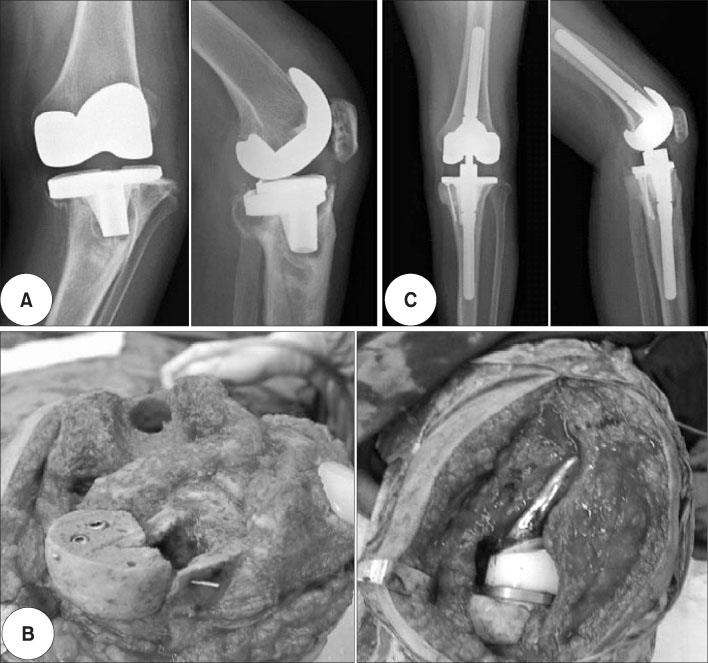J Korean Orthop Assoc.
2007 Dec;42(6):730-736. 10.4055/jkoa.2007.42.6.730.
Total Knee Arthroplasty with NexGen(R) System: 3-8 Year Follow-up Results
- Affiliations
-
- 1Department of Orthopedic Surgery, Arthro-Center, Ulsan University Hospital University of Ulsan College of Medicine, Ulsan, Korea. sdcho@uuh.ulsan.kr
- KMID: 1947778
- DOI: http://doi.org/10.4055/jkoa.2007.42.6.730
Abstract
-
PURPOSE: To evaluate the 3 to 8 year follow-up clinical and radiological results after NexGen(R) total knee arthroplasty (TKA).
MATERIALS AND METHODS
Ninety-six knees in 75 patients, who could be followed up more than 3 years after NexGen(R) TKA [cruciate retaining (CR) type:34, posterior cruciate substituting (PS) type:62] from March 1997 to May 2002, were evaluated retrospectively. The evaluations included the preoperative and postoperative range of motion (ROM), Knee Society Score (KSS), knee functional score, tibiofemoral angle and postoperative complications.
RESULTS
The ROM increased from preoperative mean flexion contracture of 9.3 degrees and further flexion of 116.4 degrees to a postoperative mean flexion contracture of 2.1 degrees and further flexion of 126.3 degrees (ROM: 124.2 degrees). The ROM of CR type improved from 112.7 degrees to 123.1 degrees, and the PS type improved from 105.3 degrees to 124.9 degrees (p>0.05). The KSS and knee function score improved from 54 and 41 before surgery to 94 and 87 after surgery, respectively (p>0.05). The tibiofemoral angle changed from preoperative varus 5.7 degrees to postoperative valgus 5.2 degrees. The complications were two cases of infection and two cases of early loosening.
CONCLUSION
The 3 to 8 year follow-up results after NexGen(R) TKA were satisfactory in both the CR and PS types. However, a longer term follow-up evaluation will be necessary.
MeSH Terms
Figure
Reference
-
1. Becker MW, Insall JN, Faris PM. Bilateral total knee arthroplasty. One cruciate retaining and one cruciate substituting. Clin Orthop Relat Res. 1991. 271:122–124.2. Berger RA, Rosenberg AG, Barden RM, Sheinkop MB, Jacobs JJ, Galante JO. Long-term followup of the Miller-Galante total knee replacement. Clin Orthop Relat Res. 2001. 388:58–67.
Article3. Bertin KC. Cruciate-retaining total knee arthroplasty at 5 to 7 years followup. Clin Orthop Relat Res. 2005. 436:177–183.
Article4. Buehler KO, Venn-Watson E, D'Lima DD, Colwell CW Jr. The press-fit condylar total knee system: 8- to 10-year results with a posterior cruciate-retaining design. J Arthroplasty. 2001. 15:698–701.5. Dennis DA, Komistek RD, Mahfouz MR. In vivo fluoroscopic analysis of fixed-bearing total knee replacements. Clin Orthop Relat Res. 2003. 410:114–130.
Article6. Dorr LD, Ochsner JL, Gronley J, Perry J. Functional comparison of posterior cruciate-retained versus cruciatesacrificed total knee arthroplasty. Clin Orthop Relat Res. 1988. 236:36–43.7. Hirsch HS, Lotke PA, Morrison LD. The posterior cruciate ligament in total knee surgery. Save, sacrifice, or substitute? Clin Orthop Relat Res. 1994. 309:64–68.8. Insall JN, Hood RW, Flawn LB, Sullivan DJ. The total condylar knee prosthesis in gonarthrosis. A five to nine-year follow-up of the first one hundred consecutive replacements. J Bone Joint Surg Am. 1983. 65:619–628.
Article9. Insall JN, Scott WN. Surgery of the knee. 2001. 3rd ed. Newyork: Churchill Livingstone;1663–1664.10. Ip D, Wu WC, Tsang WL. Early results of posterior-stabilised NexGen Legacy total knee arthroplasty. J Orthop Surg (Hong Kong). 2003. 11:38–42.
Article11. Kim HS, Min HJ, Yoon US, et al. The result of total knee arthroplasty with AGC system (more than 5-year follow-up). J Korean Knee Soc. 2005. 17:73–78.12. King TV, Scott RD. Femoral component loosening in total knee arthroplasty. Clin Orthop Relat Res. 1985. 194:285–290.
Article13. Kobori M, Kamisato S, Yoshida M, Kobori K. Revision of failed metal-backed patellar component of Miller/Galante-I total knee prosthesis. J Orthop Sci. 2000. 5:436–438.
Article14. Laskin RS. Total knee replacement with posterior cruciate ligament retention in patients with a fixed varus deformity. Clin Orthop Relat Res. 1996. 331:29–34.
Article15. Laskin RS, O'Flynn HM. Total knee replacement with posterior cruciate ligament retention in rheumatoid arthritis. Problems and complications. Clin Orthop Relat Res. 1997. 345:24–28.16. Lombardi AV Jr, Mallory TH, Fada RA, et al. An algorithm for the posterior cruciate ligament in total knee arthroplasty. Clin Orthop Relat Res. 2001. 392:75–87.
Article17. Lotke PA, Ecker ML. Influence of positioning of prosthesis in total knee replacement. J Bone Joint Surg Am. 1977. 59:77–79.
Article18. Maloney WJ, Schurman DJ. The effects of implant design on range of motion after total knee arthroplasty. Total condylar versus posterior stabilized total condylar designs. Clin Orthop Relat Res. 1992. 278:147–152.19. Moon KH, Cho KJ, Lee TJ, Kim HG. Total knee arthroplasty with NexGen system - minimum two years follow up results. J Korean Orthop Assoc. 2005. 40:174–180.20. Shin JY, Kho DH, Kim DH, Jung JK. The short-term results of PFC Sigma rotating-platform in total knee arthroplasty. J Korean Knee Soc. 2004. 16:15–20.21. Tanzer M, Smith K, Burnett S. Posterior-stabilized versus cruciate-retaining total knee arthroplasty: balancing the gap. J Arthroplasty. 2002. 17:813–819.22. Udomkiat P, Meng BJ, Dorr LD, Wan Z. Functional comparison of posterior cruciate retention and substitution knee replacement. Clin Orthop Relat Res. 2000. 378:192–201.
Article
- Full Text Links
- Actions
-
Cited
- CITED
-
- Close
- Share
- Similar articles
-
- Total Knee Replacement Arthroplasty with Buechel and Pappas Knee: Minimum 2-Year Follow-up
- Results of Total Knee Arthroplasty with NexGen(R) system (5-year follow up)
- Results of Total Knee Arthroplasty with NexGen LPS-flex Implant Using Navigation System (Brain Lab): Results with a 5-year Follow-up
- High-Flexion Total Knee Arthroplasty Using NexGen LPS-Flex System: Minimum 5-year Follow-up Results
- The Short-term Result of NexGen CR-Flex(R) Total Knee Arthroplasty




